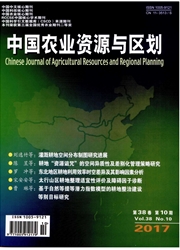

 中文摘要:
中文摘要:
水稻是我国三大粮食作物之一,其空间分布受自然条件和农业发展状况的影响,变化显著。研究水稻空间分布遥感提取是当前农业土地变化科学的热点和难点。通过对国内外研究的回顾,该文系统归纳了近年来水稻空间分布遥感提取的数据源、特征量及分类算法最新研究进展,并对其未来研究方向进行初步探讨。首先从遥感数据源方面,水稻面积监测主要采用多光谱光学影像,同时高光谱数据和雷达数据也正逐步推广应用。其次从遥感分类方法及其对应的特征量方面,包括监督和非监督分类、智能化分类算法(神经网络、支持向量机、决策树及随机森林算法)、面向对象分类、多时相植被指数法及综合提取算法等分类方法,其主要对应的特征量各有差异。最后,结合我国水稻空间分布遥感提取的实际状况,提出构建全国长时间序列水稻物候历和高时空分辨率时序NDVI数据集,大力发展基于多时相遥感分类方法和建立分层的面向对象分类方法,以及加强水稻种植北界、种植重心迁移等动态变化监测研究的建议,推动我国水稻遥感动态监测和农业土地变化科学的发展。
 英文摘要:
英文摘要:
Rice is one of the most important staple crops in China,which serves for about 65% population in China. And there has been changed a lot for its spatial- temporal distribution due to the influence of natural conditions and development status of agriculture. Therefore,accurate assessment of spatial distribution information of paddy rice is important. The research on the spatial distribution of rice area is hotspot and difficulty in the current agricultural land change science. Through the review of domestic and international research in this field,this paper scientifically summarized the spatial distribution of rice from the three aspects of remote sensing images,features and classification methods used in monitoring the paddy rice,and discussed its future research direction. First of all,according to remote sensing data,multi- spectral optical images were the main data in monitoring the rice area,such as the Landsat TM / ETM +,OLI,HJ- 1A / B,SPOT- 5,Quick Bird,MODIS and so on. And the hyper-spectral and radar images had been gradually popularizing at the same time,such as the Hyperion,ENVISAT,Radarsat- 2 and so on. Secondly,according to the remote sensing classification methods and features,the main methods included supervised and unsupervised classification,intelligent classification( back propagation neural network method,support vector machine method,decision tree and random forest method),object- oriented classification,time series vegetation index classification,comprehensive classification and so on,but features were diverse for corresponding class methods. Spectral features were usually used in supervised and unsupervised classification methods,but textural feature and other non- remote sensing features were usually added into the intelligent classification and object- oriented classification method. And time series vegetation index features were used in time series vegetation index classification,such as the Normalized Difference Vegetation Index( NDVI), Enhanced Vegetation Index( EVI) and l
 同期刊论文项目
同期刊论文项目
 同项目期刊论文
同项目期刊论文
 Simulated impact of elevated CO2, temperature, and precipitation on the winter wheat yield in the No
Simulated impact of elevated CO2, temperature, and precipitation on the winter wheat yield in the No 期刊信息
期刊信息
